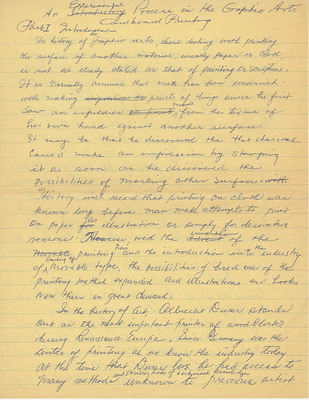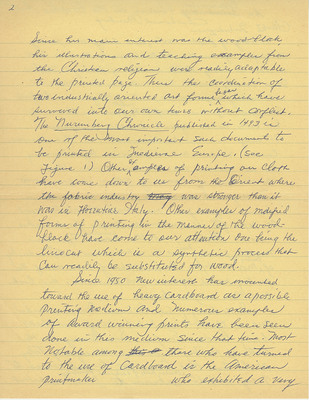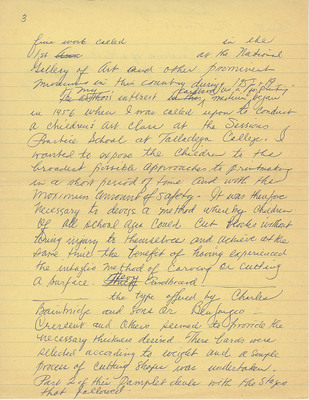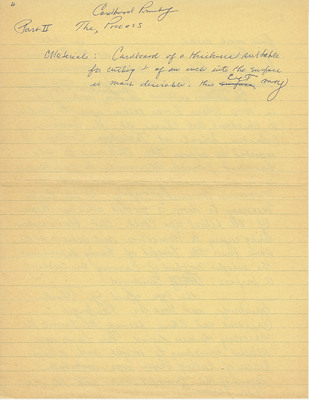Pages
MS01.01.03.B02.F18.001
[HANDWRITTEN ON YELLOW PAPER]
An [crossed out] Introductory [/crossed out] Experimental Process in the Graphic Arts Cardboard Printing
Part I Introduction
The history of the graphic arts, those dealing with printing the surface of another material, usually paper or cloth, is not as clearly state as that of painting or sculpture. It is normally assumed that man has been concerned with making [crossed out] impressions or [/crossed out] prints of things since he first saw an impression [crossed out] or print [/crossed out] made from the texture of his own hand against another surface. It may be that he discovered the that charcoal could make an impression by stamping it as soon as he discovered the possibilities of marking other surfaces. [crossed out]with [/crossed out] History will record that printing on cloth was known long before man made attempts to print on paper [crossed out] for [/crossed out] as illustrations or simply for decorative reasons. However, with the [crossed out] advent [/crossed out] invention of the [crossed out] movable [/crossed out] printing press and the introduction into the industry of printing of movable type, the possibilities of brod [broad?] uses of the printing method expanded and illustrations and books were their [there/] in great demand.
In the history of Art, Albrecht Durer stands out as the most important printer of wood-blocks during Renaissance Europe. Since Germany was the center of printing as we know the industry today. At the time that Durer live[d/] he had access to many methods and various kinds of technical knowledge unknown to previous artist.
MS01.01.03.B02.F18.002
2
Since his main interest was the wood-block, his illustrations and teaching examples from the Christian religion were readily adaptable to the printed page. Thus the coordination of two industrically oriented art forms began which have survived with our own times without conflict. The [underscored] Nuremberg Chronicle [/underscored] published in 1493 in one of the most important such documents to be printed in Medieval Europe. (see Figure 1) Other examples of printing on cloth have come down to us from the Orient where the fabric industry [crossed out] may [/crossed out] was stronger than it was in Florentine Italy. Other examples of modified forms of printing in the manner of the wood-block have come to our attention one being the linocut which is a synthetic process that can readily be substituted for wood.
Since 1950 new interest has mounted toward the use of heavy cardboard as a possible printing medium and numerous examples of award winning prints have been seen done in this medium since that time. Most notable among [crossed out] this [/crossed out] those who have turned to the use of cardboard is the American printmaker [blank space] who exhibited a very
MS01.01.03.B02.F18.003
3
fine work called [blank space] in the 1st [crossed out] Ann [/crossed out] [blank space] at the National Gallery of Art and other prominent museums in this country during 1955 & 19__.
[crossed out] The author's [/crossed out] My interest [crossed out] in this [/crossed out] cardboard as a medium for printing began in 1957 when I was called upon to conduct a children's art class at the Sessions Practice School at Talladega College. I wanted to expose the children to the broadest possible approaches to printmaking in a short period of time and with the maximum amount of safety. It was therefore necessary to devise a method whereby children of all school ages could cut blocks without bring[ing?] injury to themselves and achieve at the same time the benefit of having experienced the intaglio method of carving or cutting a surface. [crossed out] Thick [/crossed out] Heavy cardboard ______________________ the type offered by Charles Bainbridge and sons or Benfargo Crescent and others seemed to provide the necessary thickness desired. The bards were selected according to weight and a simple process of cutting shapes was undertaken. Part 2 of this pamphlet deals with the stages that followed.
MS01.01.03.B02.F18.004
4
Cardboard Printing
Part II The Process
Materials: cardboard of a thickness suitable for cutting of [off?] and inch into the surface is most desirable. This [crossed out] surface [/crossed out] ??? may





